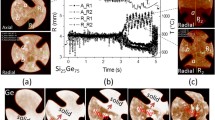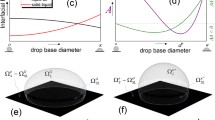The dependence of contact angles on gravity in conditions simulating reduced gravitational force is studied. The contact angles for various solid–liquid systems are measured using both lowtemperature liquids (water, glycerin, hyposulfite, phosphoric acid) and metal melts (tin, silver). It is found that gravity has no effect on the contact angle when solids are wetted by liquids. The final answer to the question how gravity influences the contact angle can be given after experiments performed in conditions of a space station.







Similar content being viewed by others
References
T. Young, “An essay on the cohesion of fluids,” Philos. Trans. R. Soc. London, 95, 65–87 (2004).
Yu. V. Naidich, Contact Phenomena in Metallic Melts [in Russian], Naukova Dumka, Kyiv (1972), p. 196.
A. W. Adamson, Physical Chemistry of Surfaces: 5th ed., Wiley, New York (1990), p. 777.
J. J. Bikerman, Contribution to the Thermodynamics of Surfaces, Cambridge, Massachusetts (1961), p. 40.
B. A. Pethica and Y. J. P. Pethica, “The contact angle equilibrium,” in: Proc. 2nd Int. Congress on Surface Activity, Butterworth Scientific, London (1957), Vol. 3, p. 131.
L. Yixiong and R. M. German, “Contact angle and solid–liquid–vapor equilibrium,” Acta Mater., 44, No. 4, 1657–1663 (1996).
S. I. Budurov, P. A. Petrov, P. D. Kovachev, et al., “Determination of contact angles in microgravity conditions,” in: Salyut 6–Soyuz. Materials Science and Technology [in Russian], Nauka, Moscow (1985), pp. 64–66.
D. Brutin, Z. Zhu, O. Rahli, et al., “Sessile drop in microgravity: creation, contact angle and interface,” Microgravity Sci. Technol., 21, No. 1, 67–76 (2009).
M. V. Bartashevich, V. V. Kuznetsov, and O. A. Kabov, “Gravity effect on the axisymmetric drop spreading,” Microgravity Sci. Technol., 22, No. 1, 107–114 (2010).
T. Enz, S. Steinbach, D. Simicic, et al., “First experiments using the materials science laboratory on board the international space station,” Microgravity Sci. Technol., 23, No. 3, 345–353 (2011).
A. Diaina, M. Castillo, D. Brutin, et al., “Sessile drop wettability in normal and reduced gravity,” Microgravity Sci. Technol., 24, No. 3, 195–202 (2012).
V. I. Nizhenko, B. B. Bogatyrenko, A. G. Kostornov, et al., “Wetting of structural materials of lowtemperature heat pipes with coolants,” in: Melt Surface Properties [in Russian], Naukova Dumka, Kyiv (1982), pp. 278–283.
A. G. Kostornov, “Capillary transport of low-viscosity liquids in porous metallic materials under the action of gravitational force,” Powder Metall. Met. Ceram., 42, No. 9–10, 447–459 (2003).
Yu. V. Naidich, V. P. Krasovskii, A. G. Kostornov, et al., “Study on wettability of metallic surface with organic liquids for application of capillary structures in heat tubes,” Adgez. Raspl. Paika Mater., Issue 37, 72–79 (2004).
Yu. V. Naidich, I. I. Gab, T. V. Stetsyuk, et al., “Effect of gravity on wettability and capillary phenomena at the liquid–solid interface,” Kosm. Nauka Tekhnol., 19, No. 5, 50–55 (2013).
B. D. Summ and Yu. V. Goryunov, Physicochemical Fundamentals of Wetting and Spreading [in Russian], Khimiya, Moscow (1976), p. 232.
W. N. Bond, “Bubbles and drops and Stokes’ law (paper 1),” Philos. Mag., 29, No. 4, 889–898 (1927).
W. N. Bond and D. A. Newton, “Bubbles, drops and Stokes’ law (paper 2),” Philos. Mag., 30, No. 5, 794–800 (1928).
I. I. Gab, T. V. Stetsyuk, and B. D. Kostyuk, “Guidelines and equipment to study the wetting of solids with low-temperature liquids in terrestrial conditions and under microgravity at an international space station,” Adgez. Raspl. Paika Mater., Issue 45, 41–47 (2012).
Author information
Authors and Affiliations
Corresponding author
Additional information
Translated from Poroshkovaya Metallurgiya, Vol. 55, Nos. 11–12 (512), pp. 115–121, 2016.
Rights and permissions
About this article
Cite this article
Naidich, Y.V., Gab, I.I., Stetsyuk, T.V. et al. Simulation of the Microgravity Effect on Wettability of Solids with Different Liquids. Powder Metall Met Ceram 55, 726–731 (2017). https://doi.org/10.1007/s11106-017-9860-1
Received:
Published:
Issue Date:
DOI: https://doi.org/10.1007/s11106-017-9860-1




